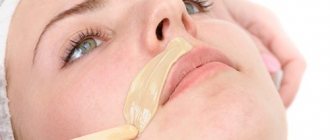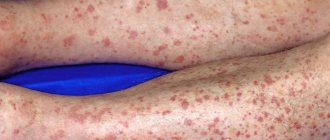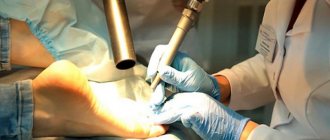Quite often, people encounter such an unpleasant phenomenon as an internal pimple in the nose. This formation is very painful, so I want to get rid of it as soon as possible. But before you begin to treat an internal pimple in the nose, it is necessary to identify the causes and external factors that provoked its appearance. After this, it is necessary to determine the type of formation, and then select the appropriate method of treating it. And to ensure that an internal pimple in the nose never appears again, you must adhere to a number of preventive rules. It is worth understanding all these issues in more detail.
Reasons for appearance
Internal pimples in the nose differ from acne, comedones and other types of inflamed tubercles in that they are not a type of acne. Such acne also cannot be called inflammation of the follicles. An internal pimple under or inside the nose appears due to infection. It can be of viral or bacterial origin. The pathogen affects the mucous membrane in the nose and the skin around the nasal passage, as well as the hair follicles that grow in this area.
When the microflora of the nasal sinuses changes and the human immune system weakens, favorable conditions are created for the appearance of painful inflammations, which are localized on the inside of the olfactory organ. A large number of different pathogenic viruses and bacteria pass through the nose every day. When its internal cavity is healthy, it cleans itself. During this, all microbes are removed from the body with the help of hairs and mucus.
But if there are damage to the mucous membrane, such as small cracks, irritations, bruises, then because of this, provocateurs of inflammation can easily get inside. This can contribute to the formation of a large internal pimple on or inside the nose. Infection occurs in two ways:
- From the outside - bacterial infection.
- From the inside - viral.
Internal reasons
They provoke viral infection. Itchy small pimples that look like blisters fill with fluid. They are a type of herpes virus. This virus lives on the mucous membranes, and acne is the result of the fact that it has entered the active phase. Quite often, herpes rashes are popularly called cold pimples, since their appearance is associated with a person’s hypothermia, due to which the risk of their formation increases significantly.
It should be noted that the appearance of internal acne in some situations is a consequence of primary infection, for example, in the case of a recent viral illness. This disease is accompanied by fever, as well as an increase in body temperature.
As for secondary infection, it develops through the spread of viruses from those places where the primary infection appeared, for example, from lips that were infected with herpes. Internal pimples on the tip of the nose or inside it are prone to recurrence. Therefore, if they have already formed once, then with a high probability they can appear in the same place again after a while.
Herpes virus infection cannot be completely cured. The virus is always present in the human body, and the disease worsens during bad weather. Herpes can also appear due to climate change, too much exposure to direct sunlight, stress, and also due to too frequent “sitting” on various diets.
It is also worth remembering that herpes is an infectious disease, so it can be transmitted to a healthy person through a kiss or during the use of personal hygiene products of an infected person. However, a healthy immune system is able to overcome this disease if a person has been in contact with a sick person or is frozen.
Herpes in the nose
25.07.2018
Any case of herpes simplex infection is transmitted from an infected person to another. Common ways to spread the herpes virus are through kissing and direct contact with blisters. Once the sores break out and heal completely, they are no longer contagious. However, once a person becomes infected with the herpes simplex virus (either of the two strains), it cannot be eliminated from the body. The virus progresses to the nerve roots and lies dormant until favorable conditions arise to cause infection. Thus, the likelihood of repeated outbreaks is very high.
Treatment of herpes
To date, no cure for herpes has been formulated. Therefore, herpetic sores in the nose are treated to combat painful symptoms and shorten the healing period. Treatment options for herpes remain the same no matter where the painful lesions occur. So, no matter who is dealing with cold sores on the nose or typical cold sores on the lips, the suggested treatments, self-care tips and home remedies are the same. Below is a quick guide to treating nasal .
Since the cause of the pathogen is a virus, the obvious treatment for nasal is the administration of antiviral drugs. Based on the pathology and overall illness, your doctor may recommend one of the oral medications that is right for you. In addition, topical ointments are prescribed nasal
ulcers under any circumstances ! When using medications, it is recommended to wash your hands before and after use.
Maintaining personal hygiene and cleaning the areas affected by herpes is critical to preventing the sores from spreading to the rest of the body. Make sure the fluid-filled blisters are washed with antimicrobial soap and water. After this, wipe your nose dry with a clean towel.
To get quick results, doctors may recommend supplements of zinc, vitamin C, and lysine. They help directly or indirectly activate the body's defense mechanism to reduce the healing period. In addition, these additional treatments help reduce patients' risk of relapse.
Avoiding acidic foods and those containing arginine is an effective home remedy for treating nasal herpes . HSV has been found to require arginine and an acidic environment for replication. Thus, by depriving pathogens of their essential growth factors, the intensity of symptoms can be reduced.
nasal herpes requires maintaining a safe distance from people who carry the herpes simplex virus. And for those who have gone through painful flare-ups, avoiding triggers is an effective way to prevent a recurrence. Triggers for blisters include stress, skin trauma, prolonged sun exposure, hormonal fluctuations, alcohol consumption, a weakened immune system and illness.
If you find strange sores in nose , immediately contact a specialist so that you can be prescribed timely and correct treatment!
Published in Dermatology Premium Clinic
External provoking factors
Bacterial (external) contamination can occur for the following reasons:
- Injury to the nasal mucosa with dirty fingers.
- Using a dirty handkerchief.
- Frequent contact with the nasal mucosa of dirt and dust.
- Excessive nasal hygiene.
- Formation of cracks in the nasal mucosa due to its overdrying.
- Self-medication using drops, sprays and aerosols.
For these reasons, rashes and cracks form. In addition, inflammation can begin as a result of sinusitis, rhinitis, and sinusitis.
Diagnostics
It is possible to establish the root cause of the formation of a rash in the nasal cavity by studying the patient’s test data. Timely diagnosis helps to quickly solve the problem.
- General blood analysis. Gives a general clinical picture.
- Scraping It will help determine whether bacteria has become a provoking factor for the rash.
- Blood test for hormones. Makes it possible to detect malfunctions in the functioning of organs. For example, problems with the endocrine glands often cause acne formation.
A comprehensive study facilitates the selection of effective therapy.
What you need to know
Before treating an internal pimple in the nose, there are some things to consider. The fact is that the appearance of an internal pimple is associated with painful sensations, as well as possible health risks.
When wondering how to squeeze out an internal pimple on the nose, you should note that under no circumstances should this be done. If an inflamed tubercle appears, it is better not to touch it at all. This is especially true in cases where the internal pimple on the nose hurts. In addition, treatment methods should be determined depending on the main reason for the appearance of such formation.
If a pimple appears due to a cold, then to treat it you can use home recipes or medications that dry out the skin. You can do nothing at all, waiting for the inflamed tubercle to disappear on its own.
If the pimple is purulent, then you need to consult a doctor, since such a formation can burst at any minute, which is why bacteria can enter the bloodstream.
Treatment for cold pimples
To get rid of herpes, you need to neutralize the virus. To do this, the nostrils are treated with a special ointment, which is aimed at combating herpes. The most effective ointments are:
- "Panavir".
- "Vivorax".
- "Zovirax".
In addition, it is recommended to instill drops that contain interferon. Such products support mucosal immunity, helping to fight existing infections.
To fight the virus, experts simultaneously recommend taking oral acyclovir medications, using special antiviral rectal suppositories, and taking medications that contain interferon.
Treatment of purulent internal pimple
If a small purulent pimple has formed in your nose, you can treat it yourself at home. For this purpose, pharmaceutical preparations are used in the form of ointments, which contain antibiotics. The most effective of them are the following:
- "Levomycetinic".
- "Levomekol".
- "Tetracycline".
- Ointment "Baneotsin".
Since the pimple is in a hard-to-reach place, it is impossible to use various lotions, poultices and compresses. Therefore, all medications should be applied using a cotton swab.
Treatment of nasal boil
First of all, it is strictly forbidden to try to treat a nasal boil on your own, much less squeeze it out. Due to the high risk of developing complications with this disease, at the first symptoms you should contact an otolaryngologist.
If the boil is localized small, is in the infiltration stage, and has unexpressed symptoms, outpatient treatment is possible. If the patient applies in a timely manner, the therapeutic program consists of conservative measures: local and general antibacterial therapy, treatment of the boil with antiseptic ointments and solutions, anti-inflammatory and detoxification therapy, etc.
If, at the time of examination, the nasal boil is in an abscessed form, local and general inflammatory signs are pronounced, and there is a risk of complications, then it is necessary to carry out surgical treatment of the nasal boil (opening the boil), and only in a hospital under round-the-clock medical supervision.
Traditional medicine recipes
As for the use of alternative medicine, it is best to treat internal pimple with irrigation and inhalation. To do this, you can prepare decoctions based on the following ingredients:
- Yarrow and St. John's wort.
- Flowers of linden, marshmallow and chamomile.
- Coltsfoot and sage leaves.
- Bark of oak, viburnum and willow.
To prepare one of these preparations, you need to pour 200 g of the mixture of the above-mentioned plants into one glass of boiling water. The product is used in the form of a decoction or infusion. For treatment, 5 procedures will be sufficient, the duration of which should be about 5 minutes. However, before using folk remedies, you should pay attention to the fact that some people may have an individual intolerance to some of the components included in the infusion.
Other home treatments
At home, you can also easily prepare a remedy that will help get rid of a white (purulent) pimple on the nose. Its main task is to ensure that such a formation is treated with a strong antiseptic, as it eliminates inflammation and kills viruses, microbes and bacteria.
Regular sulfur is a very effective remedy. It must be scraped off from the matches, soaked a little in water, and then smear the resulting mixture on the pimple in the nose with a cotton swab.
You can also use sea buckthorn oil. It is applied to the inflamed tubercle using a cotton swab.
Many experts recommend using camphor or fir alcohol. But in this case, you must act very carefully, as a burn may form on the nasal mucosa.
To combat a pimple that has formed inside the nose, you can use onion or garlic juice, as well as celandine juice.
However, the most effective plant is aloe. The juice of this succulent literally draws out all the existing pus from the pimple. To do this, aloe leaves must be cut and the juice squeezed out of them, after which it is buried or applied to the affected area. This must be done until complete recovery occurs.
How is a pimple inside the nose diagnosed?
Your doctor will ask you a few questions about the symptoms of a pimple inside your nose. These include:
- What did the pimple look like when you first noticed it?
- What symptoms have you noticed related to pimples inside your nose?
- When did you notice the pimple?
- Does the pimple come out with blood or pus?
The doctor will also do a physical examination of your pimple. Imaging studies, such as a magnetic resonance imaging (MRI) or computed tomography (CT) scan of the head, can help identify possible signs of infection inside the nose.
Your doctor may also take a sample of your blood and possibly a sample of the fluid inside the pimple. A laboratory can test this sample for your type of bacteria. If bacteria is present, your doctor may prescribe an appropriate antibiotic.
Preventive measures
To prevent the formation of an internal pimple in the nose, you need to adhere to some preventive measures, which are as follows:
- It is necessary to strengthen the immune system.
- Carry out nasal hygiene regularly.
- Avoid hypothermia.
- All drugs that are instilled into the nose should be used very carefully.
- All colds, like nasopharyngeal diseases, must be treated in a timely manner.
In conclusion, it is worth noting that an internal pimple in the nose causes a person severe discomfort and pain. However, you can easily get rid of it at home using medicines and traditional medicine recipes.
Bacteria
Bacterial infection may occur in the following situations:
- neglecting personal hygiene. It is important not to go too far here. It is unacceptable not only to touch your nose with unwashed hands, but also to abuse saline solutions. Observe moderation in everything;
- for chronic diseases, for example, recurrent rhinitis and tonsillitis. Allergic rhinitis leads to large deformation of the mucous membrane, which can cause white pimples;
- with long-term use of vasoconstrictor drugs. It is recommended to use such medications for no longer than 7 days, otherwise they can lead to drying out of the mucous membrane and addiction to this medication.










